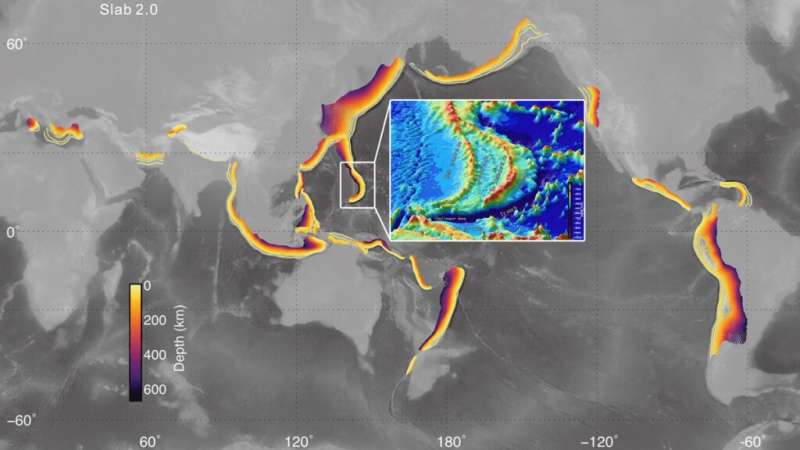Water input to the mantle at the Mariana Trench subduction zone, located at the center of this global map of subduction zones, may have been previously underestimated. Credit: Background image by USGS, overlay bathymetry figure by Chen et al., Public Domain
On the surface, subduction zones manifest as oceanic trenches, the deepest of which is the Mariana Trench in the Pacific Ocean. One notable feature of many trenches is their outer rise, a shallow bulge on the outskirts of the trench that forms as the subducting plate compresses and kinks. This compression and deformation can result in the formation of faults. These "cracks" in the seafloor are an important vector for delivering water to the mantle at subduction zones. However, high-resolution details about the structure of outer rise faults have not yet been produced.
The researchers explored the outer rise faulting around the Mariana Trench using data from 12 ocean bottom seismometers placed around the Challenger Deep, the trench's deepest point, between December 2016 and June 2017. The researchers then applied machine learning–based EQTransformer software to the seismic data, which led to the identification of 1,975 earthquakes that occurred in the region during the first half of 2017.
The locations of these earthquakes were then pinpointed using two modeling softwares, Hypoinverse and HypoDD. The level of seismic activity across the outer rise region is strongly variable, the authors found. One particular cluster of events extended to a depth of 50 kilometers, deeper than previously suspected for this region.
The observed depth extending to 50 kilometers indicates that this subduction zone is well hydrated. Not only do these results suggest that water input at the southernmost Mariana subduction zone is much higher than previously estimated, but also they provide important insights into subduction zone dynamics.
The study appears in Geophysical Research Letters.
More information: Han Chen et al, Deep Outer‐Rise Faults in the Southern Mariana Subduction Zone Indicated by a Machine‐Learning‐Based High‐Resolution Earthquake Catalog, Geophysical Research Letters (2022). DOI: 10.1029/2022GL097779
Journal information: Geophysical Research Letters
Provided by American Geophysical Union
This story is republished courtesy of Eos, hosted by the American Geophysical Union. Read the original story here.
























